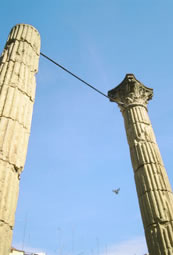
Cistercian Heritage
The austerity of the primitive Romanesque and the transition towards the Gothic are the main characteristics of the Cistercian monasteries. The order of the Cister appeared in the 12th century as a reaction against the Cluny’s exuberance and it proposed the austerity in life, liturgy and decoration of the churches. The strictest follow-up of the Rule of Saint Benet, which rejects what is superfluous, was born in the 11th century a movement of monastic renewal that believed in the need of retrieving the figure of the monk as a person made be devoted to the prayer, the work and the welcome of pilgrims.Thus, the Catalan-Aragonese sovereigns entrusted to the monks the foundation of big religious centres with many agricultural terrains, which gave life to the economy and demography of the new territories. In Catalonia, they settled in Poblet, Santes Creus and Vallbona de les Monges, so that they replied to the need of colonizing the depopulated and uncultivated lands which were conquered to the Saracens in Catalunya Nova. According to the mentioned heritage, the monasteries of Poblet and Santes Creus constitute the most important demonstrations of this art and stand in the territory of the studied tourist brand.
Regarding the three Cistercian monasteries, Santes Creus is the one that replays the Bernardian plan of construction with more faithfulness. Set up in 1150 and established in Saints Creus from 1160, the monastery passed through several glorious stages until 1835, when the expulsion of the monks was produced. Nowadays, the monastery is the only one within the Route of the Cister that does not have monastic life inside so it allows penetrating in all the corners which still preserve the memory of its splendid history. Regarding Poblet, the biggest and inhabited Cistercian monastery of Europe, it sustains a community of monks and takes part of the World Heritage list from its declaration in 1991. It is a very important point of reference in the Crown of Aragon’s history due to its use as royal pantheon by several generations of Catalan kings.
Architecturally, the monasteries get up following the spirit of the communities which lived there and the strict rules that directed them. The structure of the monasteries building is of basic importance in cloistered communities following a strict rule like Cistercians. A second precint sprang up around the central enclosure comprising the administrative offices, the abbot’s palace, a hospital and chapels for nobles or servers and dwellings for artisans. The lines and the decoration of the three monasteries follow the simplicity and soberness of the Cistercian thought.
The fact of joining the three Cistercian monasteries through the known Route of the Cister, which was created in 1989, has become an indisputable injection for the tourism of the three counties - the Conca de Barberà, l’Alt Camp and l’Urgell - which have not skimped efforts to introduce their culture, gastronomy, tradition and heritage.
